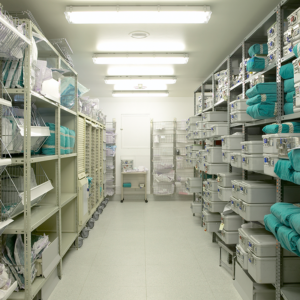Interventional Care


We notice that you are visiting us from . This site only services US-based visitors. Would you like to visit the site that is appropriate for your location?

The pandemic of SARS-CoV-2 has upended healthcare delivery in unprecedented ways. Availability of essential medical supplies have come up short as a result of increased demand, manufacturing delays, international trade/shipping delays and lack or shortages of raw materials.
This is especially true of personal protective equipment (PPE) such as medical respirators, but hospital-grade disinfectants are not immune from these concerns.1 Disinfectants are further complicated by the newness of the virus, necessitating EPA’s recommended List N: Disinfectants for Use Against SARS-CoV-2, which in turn leads to increased demand for select disinfectant products. 2
As of this writing (September 2020) there is little evidence to suggest that these concerns are easing. The Centers for Disease Control and Prevention (CDC) has addressed supply chain related issues for the SARS-CoV-2 pandemic for PPE but has not offered similar guidance specific to disinfectant supply disruptions. These guidelines describe scenarios for contingency and crisis capacity.3 Uncertain times warrant proactive, creative planning and navigating the presumably turbulent future will necessitate a combination of tracking, conservation and mitigation. This document seeks to address each of these three areas though it is not feasible to comprehensively address all potential scenarios.
Tracking
In order to mitigate supply shortages, it is essential that facilities know, understand and continuously track stock. Often, supply chain management may have existing resources to assist. However, if this is not the case, there is an alternate option.
In April 2020, National Institute for Occupational Safety and Health (NIOSH) and the CDC released a no-cost PPE Burn Rate Calculator application for desktop and mobile devices on Apple® and Android platforms. Despite the name and default settings, the user can create additional categories beyond gown, gloves and respirators (e.g. List N disinfectant wipe, List N disinfectant spray, non-List N disinfectant wipe) in order to similarly track and trend utilization by patient volume. After only two days of data points, the program can estimate when the supply of disinfectant(s) will run out and continues to update as additional data points (days) are entered. Users can use this information to optimize ordering as well as determine whether conservation efforts are successfully impactful (burn rate goes down).CLICK HERE to see a sample.
Conservation
Conserving disinfectants can be achieved through several strategies. Dedicating otherwise non-dedicated patient care equipment (assist devices, glucometers, wireless tablets) to suspected or confirmed COVID-19 case patient rooms reduces the need to disinfect between each use to patient discharge/transfer.
If an organization’s supply includes List N and non-List N disinfectants, allocate the List N products according to need. While confirmed or suspected COVID-19 cases are the obvious highest risk/need, intake/assessment areas such as Urgent Care Clinics and Emergency Departments should also be considered high risk, while elective procedure areas with pre-admission screening/testing and case delay of suspect or known positives may be considered lower risk. Ideally, each patient care area should be assessed for risk and List N disinfectants allocated according to need and product availability in the context of area specific utilization/burn rate.
Some applicators may be more conservative in their product utilization than others. For example, a pour-based disinfectant may use more product for a task than if the same product was applied to a plain disposable towelette applicator or spray bottle – although doing so violates manufacturer’s instructions for use-thus warranting a risk assessment and applicator labelling/employee education. Importantly, the EPA specifically advises against this activity as using the product in a manner inconsistent with its labeling is a violation of federal law. 4 Overall it is important to consider products that will sustain a longer use case and adhere to manufacturing guidelines (or instructions for use).
Mitigation
Conservation may not be enough to afford sufficient quantities of surface disinfectants. Mitigation strategies can range from inconvenient to high risk from a safety and/or regulatory perspective.
Facilities may seek out or be offered alternative products than they customarily utilize. Product conversions can be challenging under ideal conditions-yet alone during a pandemic. Facilities undergoing such conversion(s) should make certain that their employees are well informed of the following:
If the facility is unable to secure any List-N disinfectants and they screen or treat confirmed or suspect COVID-19 patients, facilities should communicate with local and/or state public health agencies who may be able to assist in procurement.
References